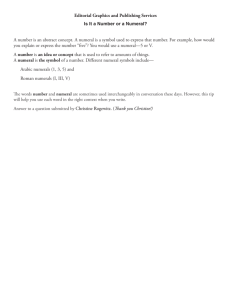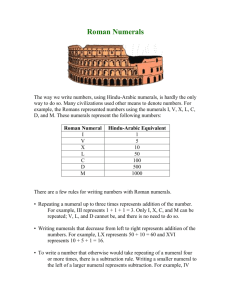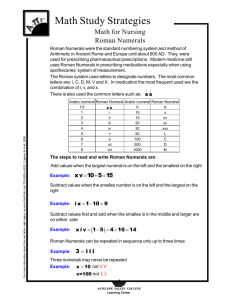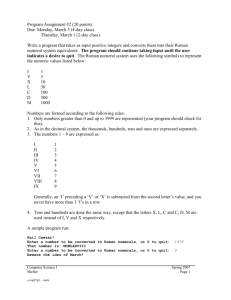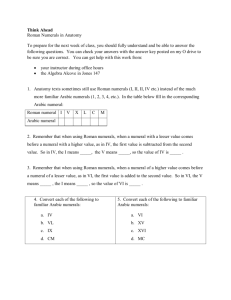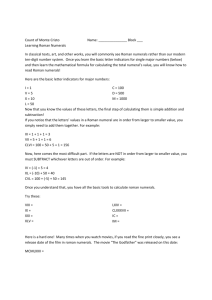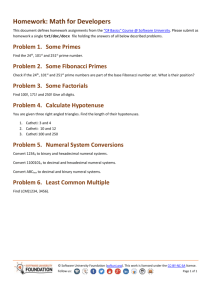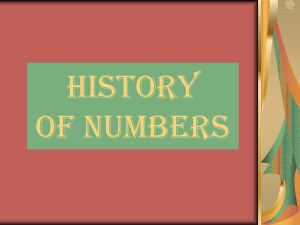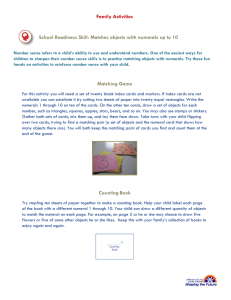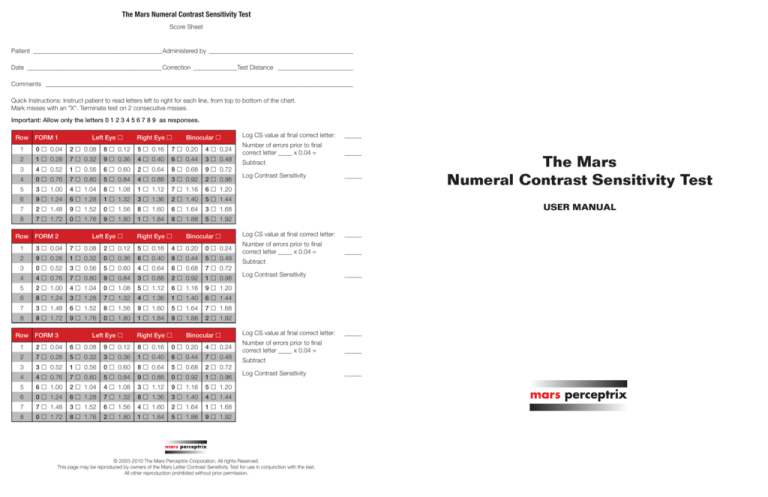
The Mars Numeral Contrast Sensitivity Test
Score Sheet
Patient __________________________________________Administered by _______________________________________________
Date____________________________________________Correction_______________Test Distance _________________________
Comments ___________________________________________________________________________________________________
Quick Instructions: Instruct patient to read letters left to right for each line, from top to bottom of the chart.
Mark misses with an "X". Terminate test on 2 consecutive misses.
Important: Allow only the letters 0 1 2 3 4 5 6 7 8 9 as responses.
Row
FORM 1
1
0 0.04
2 0.08
8 0.12
5 0.16
7 0.20
4 0.24
2
1 0.28
7 0.32
9 0.36
4 0.40
6 0.44
3 0.48
3
4 0.52
1 0.56
6 0.60
2 0.64
8 0.68
9 0.72
4
0 0.76
7 0.80
5 0.84
4 0.88
3 0.92
2 0.96
5
3 1.00
4 1.04
8 1.08
1 1.12
7 1.16
6 1.20
6
9 1.24
6 1.28
1 1.32
3 1.36
2 1.40
5 1.44
7
2 1.48
9 1.52
0 1.56
8 1.60
6 1.64
3 1.68
8
7 1.72
0 1.76
9 1.80
1 1.84
8 1.88
5 1.92
Row
FORM 2
1
3 0.04
7 0.08
2 0.12
5 0.16
4 0.20
0 0.24
2
9 0.28
1 0.32
0 0.36
6 0.40
8 0.44
5 0.48
3
0 0.52
3 0.56
5 0.60
4 0.64
6 0.68
7 0.72
4
4 0.76
7 0.80
9 0.84
3 0.88
2 0.92
1 0.96
5
2 1.00
4 1.04
0 1.08
5 1.12
6 1.16
9 1.20
6
8 1.24
3 1.28
7 1.32
4 1.36
1 1.40
6 1.44
7
3 1.48
6 1.52
8 1.56
9 1.60
5 1.64
7 1.68
8
8 1.72
9 1.76
0 1.80
1 1.84
8 1.88
2 1.92
Row
FORM 3
1
2 0.04
6 0.08
9 0.12
8 0.16
0 0.20
4 0.24
2
7 0.28
5 0.32
3 0.36
1 0.40
6 0.44
7 0.48
3
3 0.52
1 0.56
0 0.60
8 0.64
5 0.68
2 0.72
4
4 0.76
7 0.80
5 0.84
9 0.88
0 0.92
1 0.96
5
6 1.00
2 1.04
4 1.08
3 1.12
9 1.16
5 1.20
6
0 1.24
6 1.28
7 1.32
8 1.36
3 1.40
4 1.44
7
7 1.48
3 1.52
6 1.56
4 1.60
2 1.64
1 1.68
8
0 1.72
8 1.76
2 1.80
1 1.84
5 1.88
9 1.92
Left Eye
Left Eye
Left Eye
Right Eye
Right Eye
Right Eye
Binocular
Binocular
Binocular
Log CS value at final correct letter:
Number of errors prior to final
correct letter
x 0.04 =
Subtract
Log Contrast Sensitivity
The Mars
Numeral Contrast Sensitivity Test
USER MANUAL
Log CS value at final correct letter:
Number of errors prior to final
correct letter
x 0.04 =
Subtract
Log Contrast Sensitivity
Log CS value at final correct letter:
Number of errors prior to final
correct letter
x 0.04 =
Subtract
Log Contrast Sensitivity
© 2003-2010 The Mars Perceptrix Corporation. All rights Reserved.
This page may be reproduced by owners of the Mars Letter Contrast Sensitivity Test for use in conjunction with the test.
All other reproduction prohibited without prior permission.
Description
The Mars Numeral Contrast Sensitivity Test is a set of charts
for testing peak visual contrast sensitivity. While the more
familiar visual acuity test assesses resolution of the eye and
visual system and the processing of high retinal image spatial
frequencies, this test instead assesses processing of relatively
low retinal spatial frequencies. Low spatial frequency processing can be diminished by a host of retinal disorders and by
ocular media opacities and other optical disorders, often with
minimal or no diminution of visual acuity. As such it is a useful
instrument in the clinician's toolbox. The test can be used for
establishing baseline contrast sensitivity prior to an intervention
(such as cataract extraction), for identifying functional losses in
low contrast perception (often associated with glare sensitivity), or for functionally monitoring disease progression. Its small
format makes it ideal for near testing and for use in small office
or laboratory spaces, and atypical locations such as mobile eye
clinics and patients' homes. With a design based on and similar
to the widely used Mars Letter Contrast Sensitivity Test, it
uses Arabic numerals1, which may be more familiar to many
patients than Roman letters. Both tests follows the design practices recommended by the Committee on Vision of the U.S.
National Academy of Sciences and National Research Council
(Advances in Ophthalmology, 41,103-148,1980) in terms of
luminance, font, and optotype spacing. The test system is a set
of three printed charts, supplied in three forms for independent
left eye, right eye and binocular testing. The three forms, whose
number is identified at the bottom of each chart, are identical
except for the sequence of numerals. A sample score sheet can
be found on the back cover of this manual. This score sheet
may be photocopied for use by owners of the test.
Each chart form consists of 48 numerals, each subtending 2
deg at a 50 cm test distance (or 2.5 deg at 40 cm), arranged in
eight rows of six numerals each. The contrast of each numeral,
reading from left to right, and continuing on successive lines,
decreases by a constant factor (0.04 log unit). The patient
simply reads the numerals across lines and down the chart, as
in standard letter acuity measurement. (Instead of the numerals decreasing in size, however, they decrease in contrast.) The
contrast of the final numeral before which the patient misidentifies two consecutive numerals, with a correction for earlier
incorrect responses, determines the log contrast sensitivity
(CS). Contrast values associated with log CS scores of the
Mars CS tests are given in the following table:
How to Administer the Mars Numeral
Contrast Sensitivity Test
Illumination: For best results, the chart should be illuminated
uniformly, with an optimal luminance in the chart's white
background of 85 cd/m2. The chart's small size facilitates this,
and the lamp on a standard ophthalmic equipment stand will
generally provide sufficient and sufficiently uniform illumination.
Luminance should be at least 60 and less than 120 cd/m2 in
all white areas of the chart. Luminance is best checked with
a photometer. However, if one is not available, an inexpensive
incident light meter can be used; illuminance should be in the
range 189 to 377 lux, and optimally 267 lux. Testing should not
be conducted through any coatings, laminations, or coverings
on the chart, even if these are transparent or translucent.
Viewing distance and correction: The patient's viewing
distance to the chart is by design 50 cm (20 inches), but may
range from the standard near refraction distance of 40 cm
(15.75 inches) to 59 cm (23 inches). Patients should wear their
appropriate near correction, or their distance correction, with
an add of +2.00 D, and an occluder or patch on the untested
eye. The test is quite tolerant of small refractive errors since the
numerals are large (20/480 equivalent at 50 cm). Testing, however, should be performed with the eyes undilated. For patients
with very low visual acuity who cannot easily read the highest
contrast numerals, test distance may be shortened to 25 cm
(increasing the add, if necessary, to +4.00 D); in this case care
must be taken not to allow the patient's head to occlude the
light source illuminating the chart.
Instructions to the patient: Ask the patient to read the
numerals from left to right across each line of the chart. If the
patient gives a response other than a numeral (e.g. a letter), do
not score the response as incorrect. Instead, inform the patient
of the restricted numeral set, and ask for another response.
This is in order to support the assumption that the probability
of a guess is 1/10. Encourage the patient to guess even
when they report that the numerals appear too faint.
Recording responses and scoring: On the score sheet, mark
in the grid corresponding to the chart form used, an X for each
numeral incorrectly identified. Terminate testing only when the
patient makes two consecutive errors or reaches the end of
the chart. Do not terminate the test because the patient has
given up and has stopped responding. If this happens, encour-
age the patient to guess, and score the guesses as ordinary
responses. This will help to ensure that the score is based on
what the patient can see and not on what the patient believes
he or she can see.
Example scoring: In the example below, the test terminates
after the patient has read the first numeral on the seventh row,
because the consecutive numerals 5 and 2 were missed. The
log CS value at the final correct numeral (2) is 1.40. A scoring
correction of 0.04 is sUbtracte.d from this score because this
patient also erred on the 3 a few numerals earlier in the test.
The log contrast sensitivity (log CS) score is given by the log
contrast sensitivity value at the lowest contrast numeral just
prior to two incorrectly identified numerals, minus a scoring correction. The numeral just prior to the two consecutive misses is called the final correct numeral. If the patient
reaches the end of the chart without making two consecutive
errors, then the final correct numeral is simply the final numeral
correctly identified.
Row
FORM 1
1
0 0.04
2 0.08
8 0.12
5 0.16
7 0.20
4 0.24
2
1 0.28
7 0.32
9 0.36
4 0.40
6 0.44
3 0.48
3
4 0.52
1 0.56
6 0.60
2 0.64
8 0.68
9 0.72
4
0 0.76
7 0.80
5 0.84
4 0.88
3 0.92
2 0.96
5
3 1.00
4 1.04
8 1.08
1 1.12
7 1.16
6 1.20
6
9 1.24
6 1.28
1 1.32
3 1.36
2 1.40
5 1.44
7
2 1.48
9 1.52
0 1.56
8 1.60
6 1.64
3 1.68
8
7 1.72
0 1.76
9 1.80
1 1.84
8 1.88
5 1.92
Left Eye
Right Eye
Binocular
Example
Log CS value at final correct letter: 1.40
Number of errors prior to final
correct letter 1 x 0.04 =
Log Contrast Sensitivity
Normal values for log contrast sensitivity
Chart Column
Chart Row
Key
1
2
3
4
5
6
1
0.04
0.08
0.12
0.16
0.20
0.24
Profound (<0.48)
2
0.28
0.32
0.36
0.40
0.44
0.48
Severe (0.52 – 1.00)
3
0.52
0.56
0.60
0.64
0.68
0.72
Moderate (1.04 – 1.48)
4
0.76
0.80
0.84
0.88
0.92
0.96
and
Normal > Age 60 (1.52 – 1.76)
5
1.00
1.04
1.08
1.12
1.16
1.20
6
1.24
1.28
1.32
1.36
1.40
1.44
and
Normal Middle/Young Adult
(1.72 – 1.92)
7
1.48
1.52
1.56
1.60
1.64
1.68
8
1.72
1.76
1.80
1.84
1.88
1.92
Note: Expect 0.15 (√2) higher values for binocular testing when two monocular
values have similar contrast sensitivity.
log CS
Contrast
log CS
Contrast
log CS
Contrast
log CS
Contrast
log CS
Contrast
log CS
Contrast
0.04
0.912
0.08
0.832
0.12
0.759
0.16
0.692
0.20
0.631
0.24
0.575
0.28
0.525
0.32
0.479
0.36
0.437
0.40
0.398
0.44
0.363
0.48
0.331
Maintenance
0.52
0.302
0.56
0.275
0.60
0.251
0.64
0.229
0.68
0.209
0.72
0.191
0.76
0.174
0.80
0.158
0.84
0.145
0.88
0.132
0.92
0.120
0.96
0.110
1.00
0.100
1.04
0.091
1.08
0.083
1.12
0.076
1.16
0.069
1.20
0.063
1.24
0.058
1.28
0.052
1.32
0.048
1.36
0.044
1.40
0.040
1.44
0.036
Charts should be stored in their portfolio case, to protect them
from light, dust and physical damage. Do not place other objects on the chart surface that can scratch or dent the charts,
and try to avoid touching their front surface, especially in the
area where the letters are printed.
1.48
0.033
1.52
0.030
1.56
0.028
1.60
0.025
1.64
0.023
1.68
0.021
1.72
0.019
1.76
0.017
1.80
0.016
1.84
0.014
1.88
0.013
1.92
0.012
he test uses the Mars Numerals font, which is copyright © 2010 Aries Arditi, Ph.D. and The Mars Perceptrix Corporation.
T
It is available without charge for research purposes and under license for commercial use.
1.36
Additional testing: To characterize contrast sensitivity more
completely, test each eye alone and both eyes together, using
different forms of the test for each to minimize letter sequence
learning effects.
The Mars Perceptrix Corporation
49 Valley View Road Chappaqua, NY 10514-2523, USA
1
0.04
Subtract
Telephone: +1 914-239-3526 • Fax: +1 914-239-3557
www.marsperceptix.com
©2003-2010 The Mars Perceptix Corporation. All rights reserved.
Description
The Mars Numeral Contrast Sensitivity Test is a set of charts
for testing peak visual contrast sensitivity. While the more
familiar visual acuity test assesses resolution of the eye and
visual system and the processing of high retinal image spatial
frequencies, this test instead assesses processing of relatively
low retinal spatial frequencies. Low spatial frequency processing can be diminished by a host of retinal disorders and by
ocular media opacities and other optical disorders, often with
minimal or no diminution of visual acuity. As such it is a useful
instrument in the clinician's toolbox. The test can be used for
establishing baseline contrast sensitivity prior to an intervention
(such as cataract extraction), for identifying functional losses in
low contrast perception (often associated with glare sensitivity), or for functionally monitoring disease progression. Its small
format makes it ideal for near testing and for use in small office
or laboratory spaces, and atypical locations such as mobile eye
clinics and patients' homes. With a design based on and similar
to the widely used Mars Letter Contrast Sensitivity Test, it
uses Arabic numerals1, which may be more familiar to many
patients than Roman letters. Both tests follows the design practices recommended by the Committee on Vision of the U.S.
National Academy of Sciences and National Research Council
(Advances in Ophthalmology, 41,103-148,1980) in terms of
luminance, font, and optotype spacing. The test system is a set
of three printed charts, supplied in three forms for independent
left eye, right eye and binocular testing. The three forms, whose
number is identified at the bottom of each chart, are identical
except for the sequence of numerals. A sample score sheet can
be found on the back cover of this manual. This score sheet
may be photocopied for use by owners of the test.
Each chart form consists of 48 numerals, each subtending 2
deg at a 50 cm test distance (or 2.5 deg at 40 cm), arranged in
eight rows of six numerals each. The contrast of each numeral,
reading from left to right, and continuing on successive lines,
decreases by a constant factor (0.04 log unit). The patient
simply reads the numerals across lines and down the chart, as
in standard letter acuity measurement. (Instead of the numerals decreasing in size, however, they decrease in contrast.) The
contrast of the final numeral before which the patient misidentifies two consecutive numerals, with a correction for earlier
incorrect responses, determines the log contrast sensitivity
(CS). Contrast values associated with log CS scores of the
Mars CS tests are given in the following table:
How to Administer the Mars Numeral
Contrast Sensitivity Test
Illumination: For best results, the chart should be illuminated
uniformly, with an optimal luminance in the chart's white
background of 85 cd/m2. The chart's small size facilitates this,
and the lamp on a standard ophthalmic equipment stand will
generally provide sufficient and sufficiently uniform illumination.
Luminance should be at least 60 and less than 120 cd/m2 in
all white areas of the chart. Luminance is best checked with
a photometer. However, if one is not available, an inexpensive
incident light meter can be used; illuminance should be in the
range 189 to 377 lux, and optimally 267 lux. Testing should not
be conducted through any coatings, laminations, or coverings
on the chart, even if these are transparent or translucent.
Viewing distance and correction: The patient's viewing
distance to the chart is by design 50 cm (20 inches), but may
range from the standard near refraction distance of 40 cm
(15.75 inches) to 59 cm (23 inches). Patients should wear their
appropriate near correction, or their distance correction, with
an add of +2.00 D, and an occluder or patch on the untested
eye. The test is quite tolerant of small refractive errors since the
numerals are large (20/480 equivalent at 50 cm). Testing, however, should be performed with the eyes undilated. For patients
with very low visual acuity who cannot easily read the highest
contrast numerals, test distance may be shortened to 25 cm
(increasing the add, if necessary, to +4.00 D); in this case care
must be taken not to allow the patient's head to occlude the
light source illuminating the chart.
Instructions to the patient: Ask the patient to read the
numerals from left to right across each line of the chart. If the
patient gives a response other than a numeral (e.g. a letter), do
not score the response as incorrect. Instead, inform the patient
of the restricted numeral set, and ask for another response.
This is in order to support the assumption that the probability
of a guess is 1/10. Encourage the patient to guess even
when they report that the numerals appear too faint.
Recording responses and scoring: On the score sheet, mark
in the grid corresponding to the chart form used, an X for each
numeral incorrectly identified. Terminate testing only when the
patient makes two consecutive errors or reaches the end of
the chart. Do not terminate the test because the patient has
given up and has stopped responding. If this happens, encour-
age the patient to guess, and score the guesses as ordinary
responses. This will help to ensure that the score is based on
what the patient can see and not on what the patient believes
he or she can see.
Example scoring: In the example below, the test terminates
after the patient has read the first numeral on the seventh row,
because the consecutive numerals 5 and 2 were missed. The
log CS value at the final correct numeral (2) is 1.40. A scoring
correction of 0.04 is sUbtracte.d from this score because this
patient also erred on the 3 a few numerals earlier in the test.
The log contrast sensitivity (log CS) score is given by the log
contrast sensitivity value at the lowest contrast numeral just
prior to two incorrectly identified numerals, minus a scoring correction. The numeral just prior to the two consecutive misses is called the final correct numeral. If the patient
reaches the end of the chart without making two consecutive
errors, then the final correct numeral is simply the final numeral
correctly identified.
Row
FORM 1
1
0 0.04
2 0.08
8 0.12
5 0.16
7 0.20
4 0.24
2
1 0.28
7 0.32
9 0.36
4 0.40
6 0.44
3 0.48
3
4 0.52
1 0.56
6 0.60
2 0.64
8 0.68
9 0.72
4
0 0.76
7 0.80
5 0.84
4 0.88
3 0.92
2 0.96
5
3 1.00
4 1.04
8 1.08
1 1.12
7 1.16
6 1.20
6
9 1.24
6 1.28
1 1.32
3 1.36
2 1.40
5 1.44
7
2 1.48
9 1.52
0 1.56
8 1.60
6 1.64
3 1.68
8
7 1.72
0 1.76
9 1.80
1 1.84
8 1.88
5 1.92
Left Eye
Right Eye
Binocular
Example
Log CS value at final correct letter: 1.40
Number of errors prior to final
correct letter 1 x 0.04 =
Log Contrast Sensitivity
Normal values for log contrast sensitivity
Chart Column
Chart Row
Key
1
2
3
4
5
6
1
0.04
0.08
0.12
0.16
0.20
0.24
Profound (<0.48)
2
0.28
0.32
0.36
0.40
0.44
0.48
Severe (0.52 – 1.00)
3
0.52
0.56
0.60
0.64
0.68
0.72
Moderate (1.04 – 1.48)
4
0.76
0.80
0.84
0.88
0.92
0.96
and
Normal > Age 60 (1.52 – 1.76)
5
1.00
1.04
1.08
1.12
1.16
1.20
6
1.24
1.28
1.32
1.36
1.40
1.44
and
Normal Middle/Young Adult
(1.72 – 1.92)
7
1.48
1.52
1.56
1.60
1.64
1.68
8
1.72
1.76
1.80
1.84
1.88
1.92
Note: Expect 0.15 (√2) higher values for binocular testing when two monocular
values have similar contrast sensitivity.
log CS
Contrast
log CS
Contrast
log CS
Contrast
log CS
Contrast
log CS
Contrast
log CS
Contrast
0.04
0.912
0.08
0.832
0.12
0.759
0.16
0.692
0.20
0.631
0.24
0.575
0.28
0.525
0.32
0.479
0.36
0.437
0.40
0.398
0.44
0.363
0.48
0.331
Maintenance
0.52
0.302
0.56
0.275
0.60
0.251
0.64
0.229
0.68
0.209
0.72
0.191
0.76
0.174
0.80
0.158
0.84
0.145
0.88
0.132
0.92
0.120
0.96
0.110
1.00
0.100
1.04
0.091
1.08
0.083
1.12
0.076
1.16
0.069
1.20
0.063
1.24
0.058
1.28
0.052
1.32
0.048
1.36
0.044
1.40
0.040
1.44
0.036
Charts should be stored in their portfolio case, to protect them
from light, dust and physical damage. Do not place other objects on the chart surface that can scratch or dent the charts,
and try to avoid touching their front surface, especially in the
area where the letters are printed.
1.48
0.033
1.52
0.030
1.56
0.028
1.60
0.025
1.64
0.023
1.68
0.021
1.72
0.019
1.76
0.017
1.80
0.016
1.84
0.014
1.88
0.013
1.92
0.012
he test uses the Mars Numerals font, which is copyright © 2010 Aries Arditi, Ph.D. and The Mars Perceptrix Corporation.
T
It is available without charge for research purposes and under license for commercial use.
1.36
Additional testing: To characterize contrast sensitivity more
completely, test each eye alone and both eyes together, using
different forms of the test for each to minimize letter sequence
learning effects.
The Mars Perceptrix Corporation
49 Valley View Road Chappaqua, NY 10514-2523, USA
1
0.04
Subtract
Telephone: +1 914-239-3526 • Fax: +1 914-239-3557
www.marsperceptix.com
©2003-2010 The Mars Perceptix Corporation. All rights reserved.
The Mars Numeral Contrast Sensitivity Test
Score Sheet
Patient __________________________________________Administered by _______________________________________________
Date____________________________________________Correction_______________Test Distance _________________________
Comments ___________________________________________________________________________________________________
Quick Instructions: Instruct patient to read letters left to right for each line, from top to bottom of the chart.
Mark misses with an "X". Terminate test on 2 consecutive misses.
Important: Allow only the letters 0 1 2 3 4 5 6 7 8 9 as responses.
Row
FORM 1
1
0 0.04
2 0.08
8 0.12
5 0.16
7 0.20
4 0.24
2
1 0.28
7 0.32
9 0.36
4 0.40
6 0.44
3 0.48
3
4 0.52
1 0.56
6 0.60
2 0.64
8 0.68
9 0.72
4
0 0.76
7 0.80
5 0.84
4 0.88
3 0.92
2 0.96
5
3 1.00
4 1.04
8 1.08
1 1.12
7 1.16
6 1.20
6
9 1.24
6 1.28
1 1.32
3 1.36
2 1.40
5 1.44
7
2 1.48
9 1.52
0 1.56
8 1.60
6 1.64
3 1.68
8
7 1.72
0 1.76
9 1.80
1 1.84
8 1.88
5 1.92
Row
FORM 2
1
3 0.04
7 0.08
2 0.12
5 0.16
4 0.20
0 0.24
2
9 0.28
1 0.32
0 0.36
6 0.40
8 0.44
5 0.48
3
0 0.52
3 0.56
5 0.60
4 0.64
6 0.68
7 0.72
4
4 0.76
7 0.80
9 0.84
3 0.88
2 0.92
1 0.96
5
2 1.00
4 1.04
0 1.08
5 1.12
6 1.16
9 1.20
6
8 1.24
3 1.28
7 1.32
4 1.36
1 1.40
6 1.44
7
3 1.48
6 1.52
8 1.56
9 1.60
5 1.64
7 1.68
8
8 1.72
9 1.76
0 1.80
1 1.84
8 1.88
2 1.92
Row
FORM 3
1
2 0.04
6 0.08
9 0.12
8 0.16
0 0.20
4 0.24
2
7 0.28
5 0.32
3 0.36
1 0.40
6 0.44
7 0.48
3
3 0.52
1 0.56
0 0.60
8 0.64
5 0.68
2 0.72
4
4 0.76
7 0.80
5 0.84
9 0.88
0 0.92
1 0.96
5
6 1.00
2 1.04
4 1.08
3 1.12
9 1.16
5 1.20
6
0 1.24
6 1.28
7 1.32
8 1.36
3 1.40
4 1.44
7
7 1.48
3 1.52
6 1.56
4 1.60
2 1.64
1 1.68
8
0 1.72
8 1.76
2 1.80
1 1.84
5 1.88
9 1.92
Left Eye
Left Eye
Left Eye
Right Eye
Right Eye
Right Eye
Binocular
Binocular
Binocular
Log CS value at final correct letter:
Number of errors prior to final
correct letter
x 0.04 =
Subtract
Log Contrast Sensitivity
The Mars
Numeral Contrast Sensitivity Test
USER MANUAL
Log CS value at final correct letter:
Number of errors prior to final
correct letter
x 0.04 =
Subtract
Log Contrast Sensitivity
Log CS value at final correct letter:
Number of errors prior to final
correct letter
x 0.04 =
Subtract
Log Contrast Sensitivity
© 2003-2010 The Mars Perceptrix Corporation. All rights Reserved.
This page may be reproduced by owners of the Mars Letter Contrast Sensitivity Test for use in conjunction with the test.
All other reproduction prohibited without prior permission.

